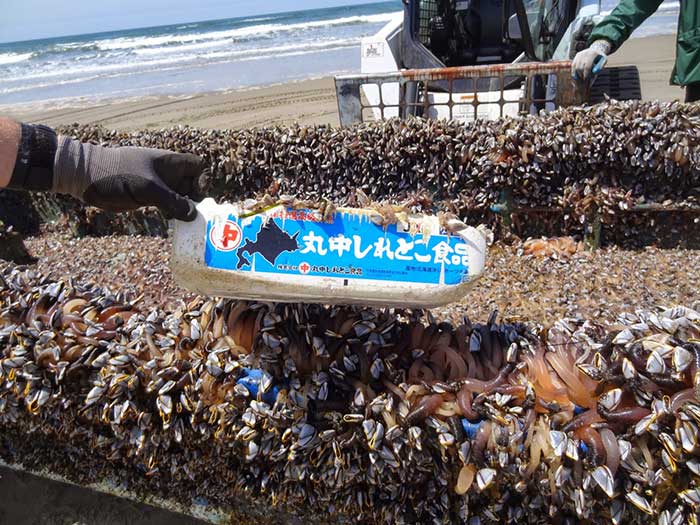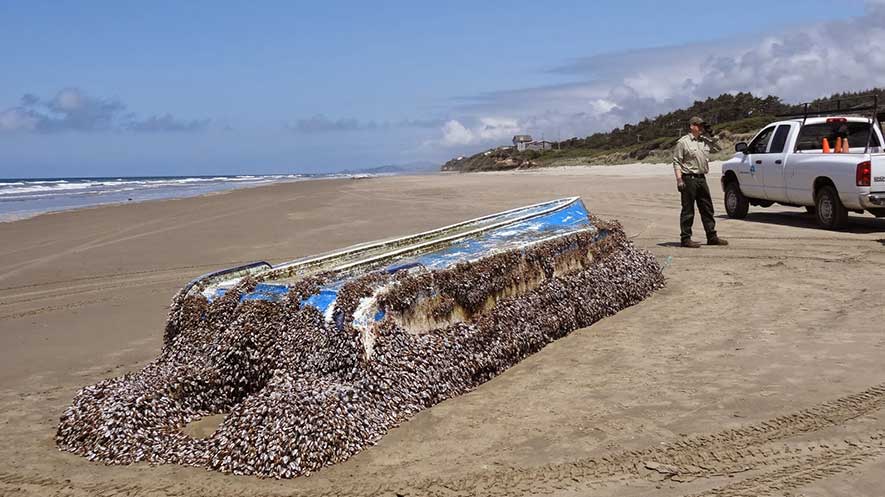Radiation isn’t the only pollutant unleashed by the massive 2011 earthquake that killed around 18,000 people and caused three nuclear reactors to melt down at the Fukushima Dai-ichi nuclear power plant. The resulting tsunami also washed 5 million tons of debris into the ocean, carrying invasive species as far as the coast of Oregon.
A new study, led by Williams College Professor Emeritus James T. Carlton and appearing in the 29 September 2017 issue of Science, documents for the first time that plastic marine debris may be significantly increasing the transport of non-native species across the world’s oceans.
Carlton and his colleagues demonstrate that, since 2012, nearly 300 species of marine life have landed alive on the coasts of North America and the Hawaiian Islands after rafting across the Pacific Ocean on debris swept out to sea by the Japanese earthquake and tsunami of March 2011.
The paper’s title is “Tsunami-Driven rafting: Transoceanic species dispersal and implications for marine biogeography.”
Because the organisms traveled on primarily non-biodegradable objects, such as fiberglass vessels and plastic buoys, they survived far longer than marine scientists predicted. Coastal species were believed to be unable to live for more than two years on the open ocean. However, the Japanese species were still arriving on American shores in 2017, six years after the tsunami.
“This study of a remarkable ocean rafting event of unprecedented magnitude and duration reveals for the first time the profound role that plastic marine debris can now play in transporting entire communities of species in the world’s oceans—for far longer lengths of time than historic dispersal on natural substrates (such as wood) would have been possible,” Carlton says.
 Hard hats, plastic debris, ropes, floats, Styrofoam, shoes, toys, wood and construction debris, and many other floating objects washed onto beaches in places like Hawaii and Oregon.
Hard hats, plastic debris, ropes, floats, Styrofoam, shoes, toys, wood and construction debris, and many other floating objects washed onto beaches in places like Hawaii and Oregon.
More than 10 million tons of plastic waste from nearly 200 countries enter the ocean every year. The authors argue that vastly expanded coastal urbanization has increased the amount of such plastic available to be washed into the sea. Hurricanes and typhoons then sweep the debris into the oceans, as happened when hurricanes struck the Caribbean and Florida Keys in fall 2017. Riding on that waste, a new wave of potential ecological invaders is pushed out to sea, where they often survive for years before landfall.
“These scientists have taken the unusual tack of looking at a natural disaster and coming to new conclusions about how our activities and structures influence species distributions in the oceans,” says David Garrison, program director in the National Science Foundation’s Division of Ocean Sciences, which co-funded the research.
The expected increase in the size and frequency of extreme weather incidents due to global climate change is likely, the authors argue, to significantly increase the amount of debris in the oceans, and, with it, the number of possible ecological invaders. This creates the potential for vast economic costs and environmental impacts.
The research on which the paper is based was a partnership between Carlton, Deborah Carlton, and Megan McCuller, all of the Williams College-Mystic Seaport Maritime Studies Program; John Chapman and Jessica Miller (Oregon State University); Gregory Ruiz and Brian Steves (Smithsonian Environmental Research Center); Jonathan Geller (Moss Landing Marine Laboratories); and Nancy Treneman (Oregon Institute of Marine Biology).
Additional funding for the research came from the Ministry of the Environment of Japan through the North Pacific Marine Science Organization.
Top Photo caption: This boat that washed ashore on the Oregon coast was teeming with pelagic gooseneck barnacles (Lepas anatifera) as well as approximately 50 non-native mussels, scallops, and drifter crabs. In the boat was a Styrofoam cooler with intact Japanese text that had likely been trapped under the vessel for two years. Photo courtesy of oregonbeachcomber.com.



